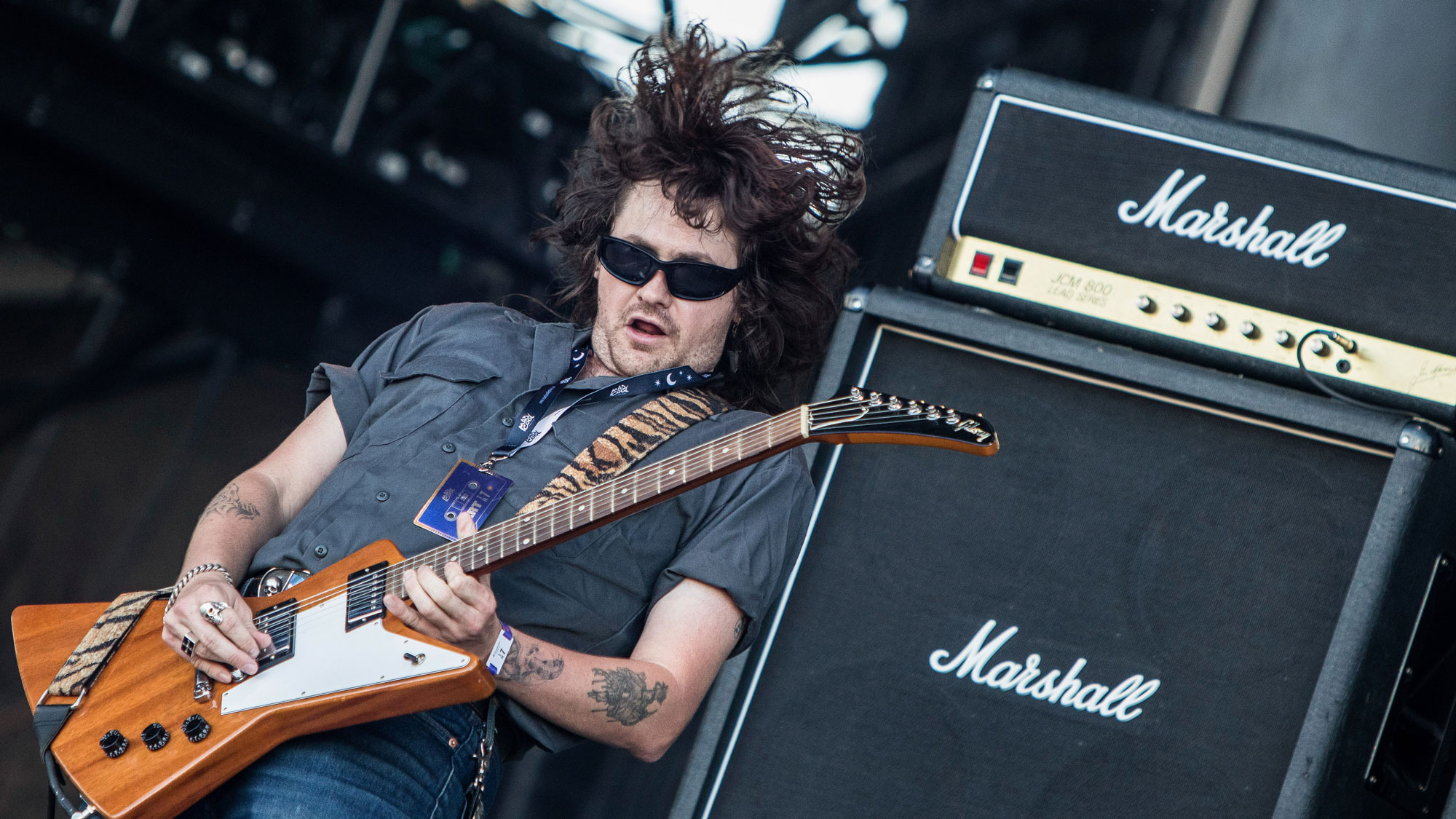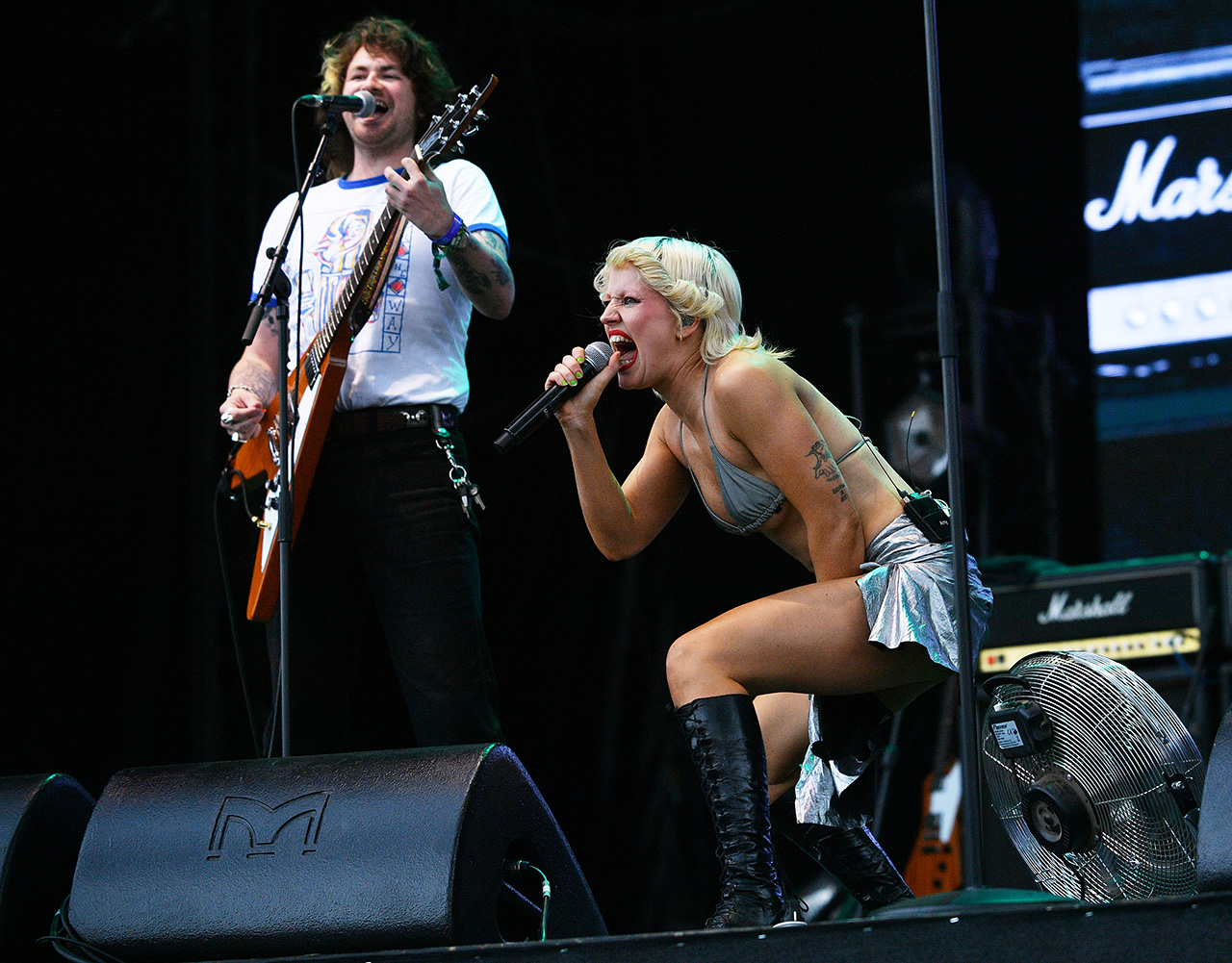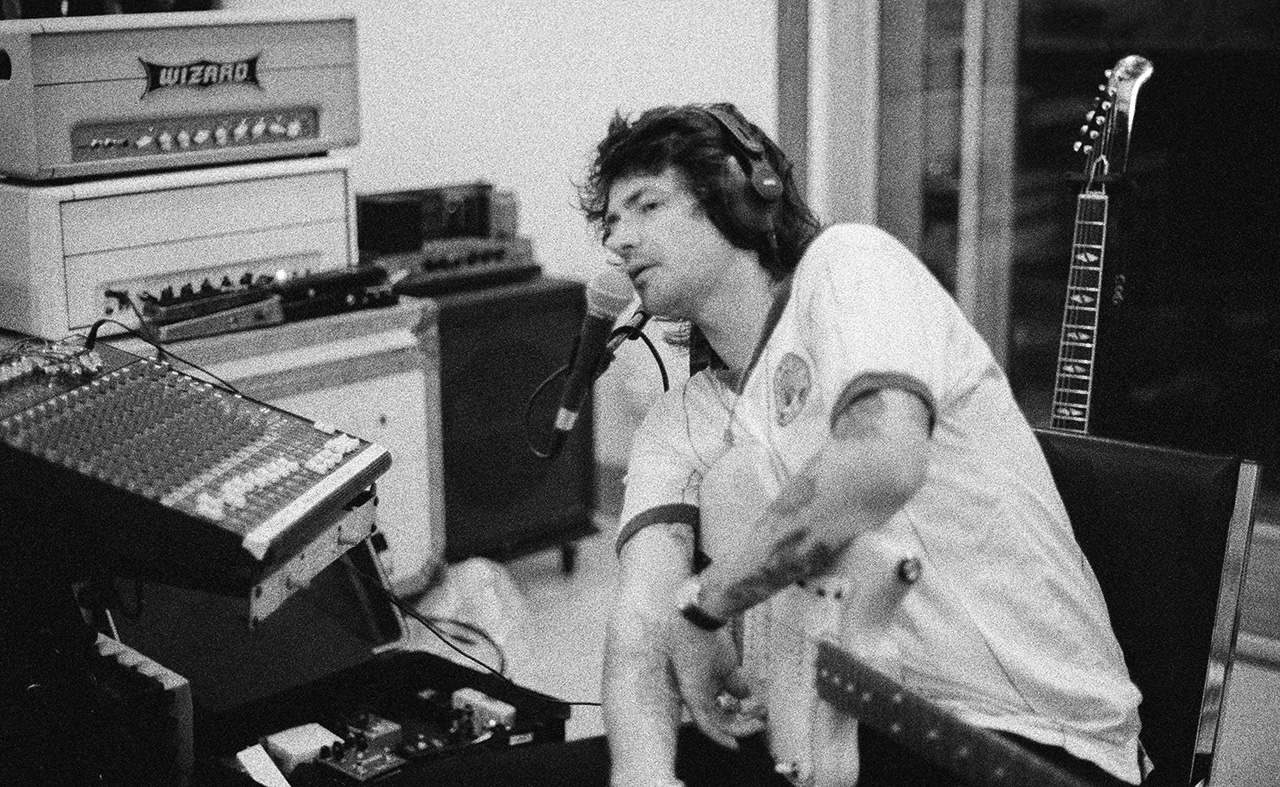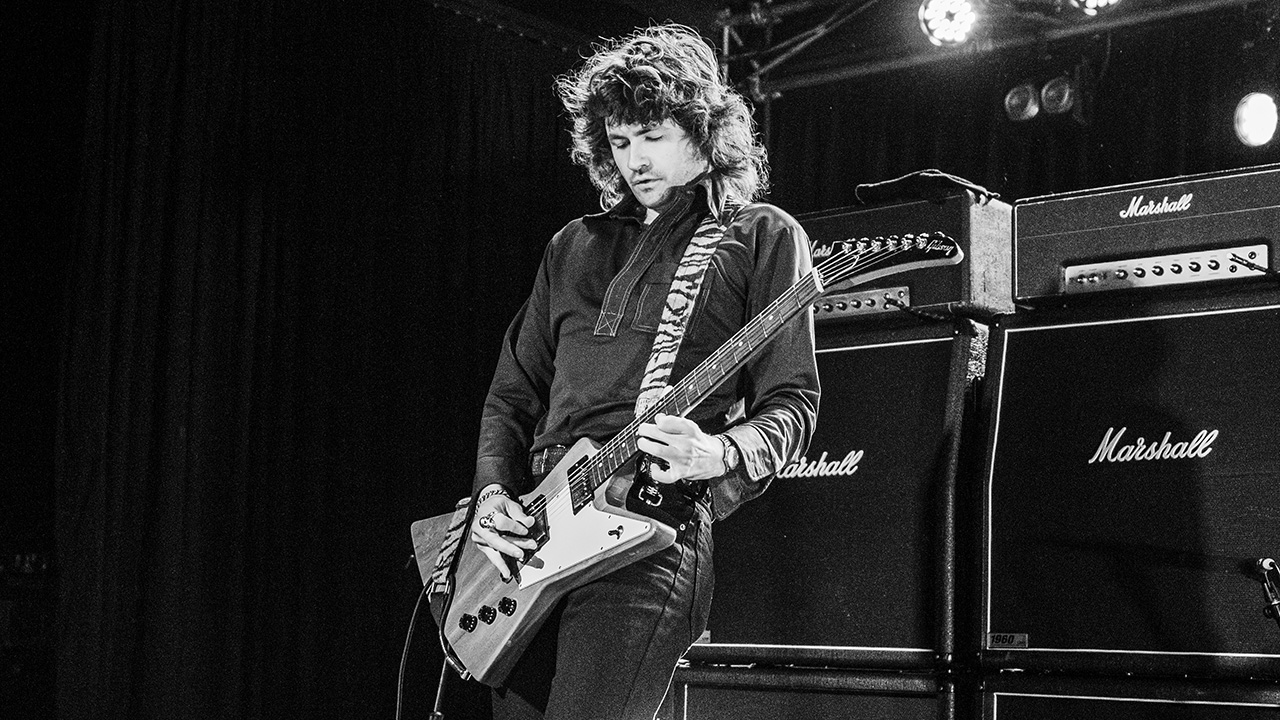“You’re hearing a shredder struggling on 11 flatwound strings trying to solo – I tried to mimic Thin Lizzy and Jurassic Park”: Amyl and the Sniffers are one of the hottest rock bands on the planet – and they got there by breaking punk’s no-solos rule
The fast-rising Australian outfit’s guitarist Declan Martens aims to sound like Angus and Malcolm Young together. He discusses his love of chunky strings, how to make guitar solos punk, and using Dave Grohl’s guitars while recording in the Foo Fighters’ studio

When writing for a vocalist like Amyl and the Sniffers’ Amy Taylor, punk-rock orthodoxy isn’t going to move the needle – not when she tears into the mic with stream-of-consciousness verses, using C- and F-bombs for punctuation.
“The traditional sort of, ‘Here’s four chords, Amy, what can you do on that?’ doesn’t work for her,” guitarist Declan Martens agrees. “She needs to feel the craziness she has on stage when she’s writing, otherwise she’s not inspired.
“I need to entertain Amy to get her to choose my riffs to write to. I guess it’s just like taking vegetables to a toddler and being like, ‘Please eat this!’”
That’s why it’s such a thrill to press play on the Australian pub punks’ third album, Cartoon Darkness: you don’t know what’s coming next. Tracked at the Foo Fighters’ Studio 606 in LA, it opens with a wall of electric guitar noise – a la Ron Asheton on the Stooges’ I Wanna Be Your Dog.
Then it goes through all kinds of evolutionary convulsions, Martens dragging his guitar through the after-hours trippiness of Big Dreams, the super-downtuned fuzz of It’s Mine, right on through to the demob-happy closer Me and the Girls, which is more hip-hop inspired.
“In the past we wrote for performing, for how we were gonna do it live,” he says. “This album, we were like, ‘Well, we’ve got our hour set – why don’t we see what we can do in a studio setting? Some of the types of songs that we haven’t been able to write before, why don’t we try to attempt those?’”
You’ve talked about producer Nick Launay finding tones for you, freeing you to concentrate on playing. But how important is the guitar itself?
Get The Pick Newsletter
All the latest guitar news, interviews, lessons, reviews, deals and more, direct to your inbox!
“I learned to play on a Strat. I feel like I’m Ritchie Blackmore – even though I know I’m very far from that. But I feel like, when I do a solo on a Strat, it’s like, ‘Check me out – I’m fucking sick!’ On a Gibson Explorer, the way it’s weighted, I feel stronger and tougher. Playing the Flying V, I feel sexier – the way it goes on your leg and you can get your hips in there a little bit!

“Playing the different guitars differently comes from how I interact with them physically, more than how I actually play them with my fingers. Like the Explorer: I hit the hell out of it. It’s just a big block of wood. And usually it stays in tune!”
People call you a reluctant shredder. How do you see the concept of shredding and virtuosity in punk?
“Two punk bands were really important to me when I was younger that have incredible guitar solos. Cosmic Psychos, from Australia, were a massive influence on Amyl and the Sniffers; they’re kind of like Motörhead but a bit more punk.
You’re hearing a shredder struggling on 11 flatwound strings trying to solo
“As an Australian, getting drunk at the pub when we were younger, it’s the same sort of thing as AC/DC. It’s like this great punk song, we’re all pissed at the pub, and the next thing is there’s a mad solo! I love it.
“The band Brats from Denmark in the early ’80s had got two insane Flying V guitarists. They’re the best hybrid of punk and metal I’ve ever heard. They went on to form Mercyful Fate, which is crazy. I found their record when I was 21, when Amyl first started.

“Back then I didn’t like solos and I couldn’t do them; I wished I could do them but I couldn’t. When I heard this album by Brats I was like, ‘Holy fuck, I need to learn how to do a guitar solo!’
“There’s definitely a space for it. The way punk bands express themselves through vocals and rhythms, and that down-picking, I just apply the same thing to my solos. I just go as crazy as I can.”
How did your solo on Pigs come about?
“You’re hearing a shredder struggling on 11 flatwound strings trying to solo! On this album I’d do all the tracks flatwound. If there’s a solo I would also solo flatwound, then later we’d drop in an overdubbed solo with roundwound strings and a much nicer tone. With that one, maybe we forgot… we just kept it in.
“The influence is Thunder and Lightning by Thin Lizzy. I’ve always thought it sounds like something from Jurassic Park, so I tried to mimic that. Nick, our producer, was like, ‘Do you want to redo this solo? At the end you kind of just keep doing the same thing.’ And I was like, ‘No, keep it in. I like it.’”
Presumably you were using different guitars – how would you choose guitars to complement that first take on flatwounds?
“For the double-tracking it was mostly the Explorer with a Loller P-90. In Chewing Gum, the high bit in the verse was roundwound, and the intro for Big Dreams was roundwound. That was on one of Dave Grohl’s Trini Lopez guitars. Then solos and lead lines were roundwound, just to bring it a bit of life.
“But I really loved flatwounds for this album. Henry Cash from Starcrawler lent me a whole bunch of Teles, so the solo on Bailing on Me is a Tele with roundwounds. Flats have a different feel. It’s quite solid.”
I’ve always called it the Chuck Berry thing; it’s the first solo thing I learned… unfortunately I probably use it way too much
And you like your strings heavy?
“It’s been a journey. We just had a rehearsal where I had my 9-46s leftover from the last tour. I was like, ‘Fuck, I can't play the new album on this gauge!’ On this album it was really important to get the single-note string hits very precise and in time. It sounds kind of wispy-wimpy on a lighter gauge. On this next tour, I’m going to have to go up a gauge.”
Besides Dave Grohl’s Trini, were there any super-fancy things kicking around at Studio 606 that you used?
“We used a cabinet that belonged to a tech who worked for Carlos Alomar and Robert Fripp. We used an Ampeg V-4 guitar amp. We used a 100-watt Hiwatt – a custom made for Studio 606. It had the XLR-shaped switch in the front of it; Jimmy Page had a custom one set up like that.”

Speaking specifically tone, what are we hearing on Me and the Girls?
“I’m just playing the octaves; it’s really driven. I was trying to get an Eddie Van Halen tone going through a phaser. Then there’s that weird boing noise, and that’s one those mouth harp things.
“I had this crazy idea about using an envelope filter into a fuzz with a talkbox, and trying to do a saxophone noise – but that will have to be on the next album.”
Your solo on Do It Do It sounds amazing with those chewy doublestops and that rhythm-lead thing. It’s very Angus Young or Chuck Berry.
“That solo was influenced by an Australian power-pop band called Sunnyboys, so I guess maybe that guy was influenced by AC/DC. But I’ve always called it the Chuck Berry thing… I learned it from Angus. That was the first solo thing I learned … unfortunately I probably use it way too much! But it’s good fun.”
What did you tune down to on It’s Mine?
“We play a half-step down, but that’s drop G#, so the A and the E string are tuned to the same note an octave out – A goes down to G# and E goes all the way down to an octave-down G#. I heard Matt Sweeney from Guitar Moves did that.”
The fuzz sound is amazing.
“It was the Boss FZ-2 Hyper Fuzz. It ended up being used on a lot of the album, even when there aren’t fuzz tones. I heard Stevie Ray Vaughan ran one of those Dunlop Fuzz Faces clean for his clean tone; I was like, ‘Fuck, if Stevie can do it, I can do it.’”
What other effects were you using?
“I modded my MXR Distortion+. Off the shelf it comes with silicon diodes so I put LEDs in, and that gives it more headroom and angrier distortion. But I don’t use that for a heavy distortion tone; I sort of use it as a preamp. I pretty much have both controls on midday and use it for a little coloring.”
Live, there’s so much more energy and distortion in the guitar tone than what there is on the album
Who are your tone idols?
“For this album, I got obsessed with Rolling Stones guitar tones from Tattoo You, Some Girls, Exile on Main Street and Sticky Fingers. A recent obsession is the difference between Malcolm and Angus Young on recordings.
“I’m like a conspiracy theorist in bed at night with headphones on! I’m like, ‘Wow, Malcolm’s so clean!’ Because that’s what I want to do live – replicate Malcolm and Angus.
“I’ve got a Hiwatt amp and a Park amp. With the Park I’m trying to get perfect Angus tone, and on the Hiwatt I’m trying to get perfect Malcolm tone, then blend them together so that I’m Malcolm and Angus together.”
I imagine you’re not overly bothered about recreating everything exactly as it is on the record.
“Definitely. Our strength is our live performance, so I don’t want to preoccupy myself too much. I hate those guitarists who look down at their pedals trying to nail every single part.
“It’s super-important for me that we still go out there and do a really entertaining show. Live, there’s so much more energy and distortion in the guitar tone than what there is on the album. If it’s done in the right way it blows you away.”
- Cartoon Darkness is out October 25 via Rough Trade.
Jonathan Horsley has been writing about guitars since 2005, playing them since 1990, and regularly contributes to publications including Guitar World, MusicRadar and Total Guitar. He uses Jazz III nylon picks, 10s during the week, 9s at the weekend, and shamefully still struggles with rhythm figure one of Van Halen’s Panama.
“Even the thought that Clapton might have seen a few seconds of my video feels surreal. But I’m truly honored”: Eric Clapton names Japanese neo-soul guitarist as one to watch
“You better be ready to prove it’s something you can do”: Giacomo Turra got exposed – but real guitar virtuosos are being wrongly accused of fakery, too












